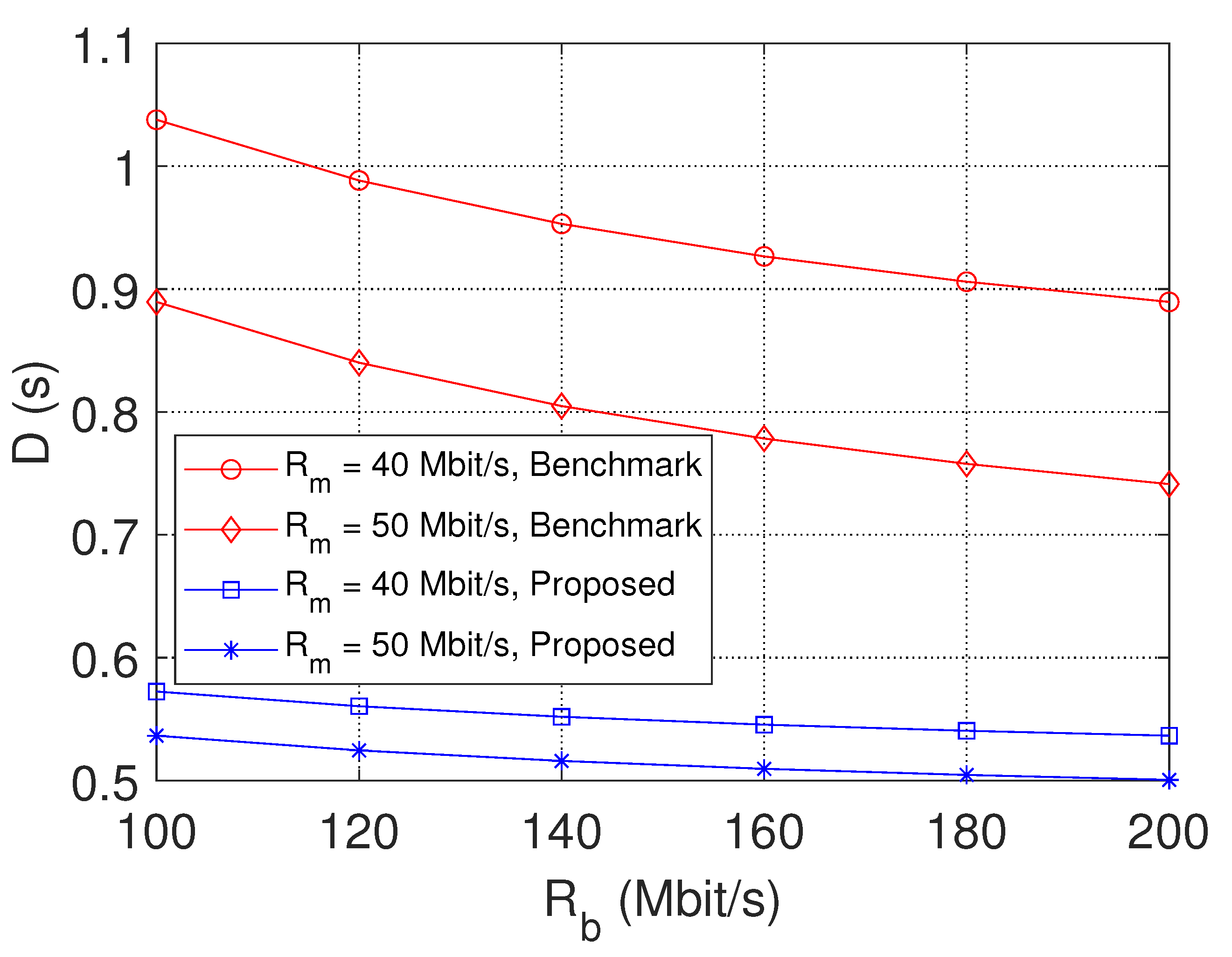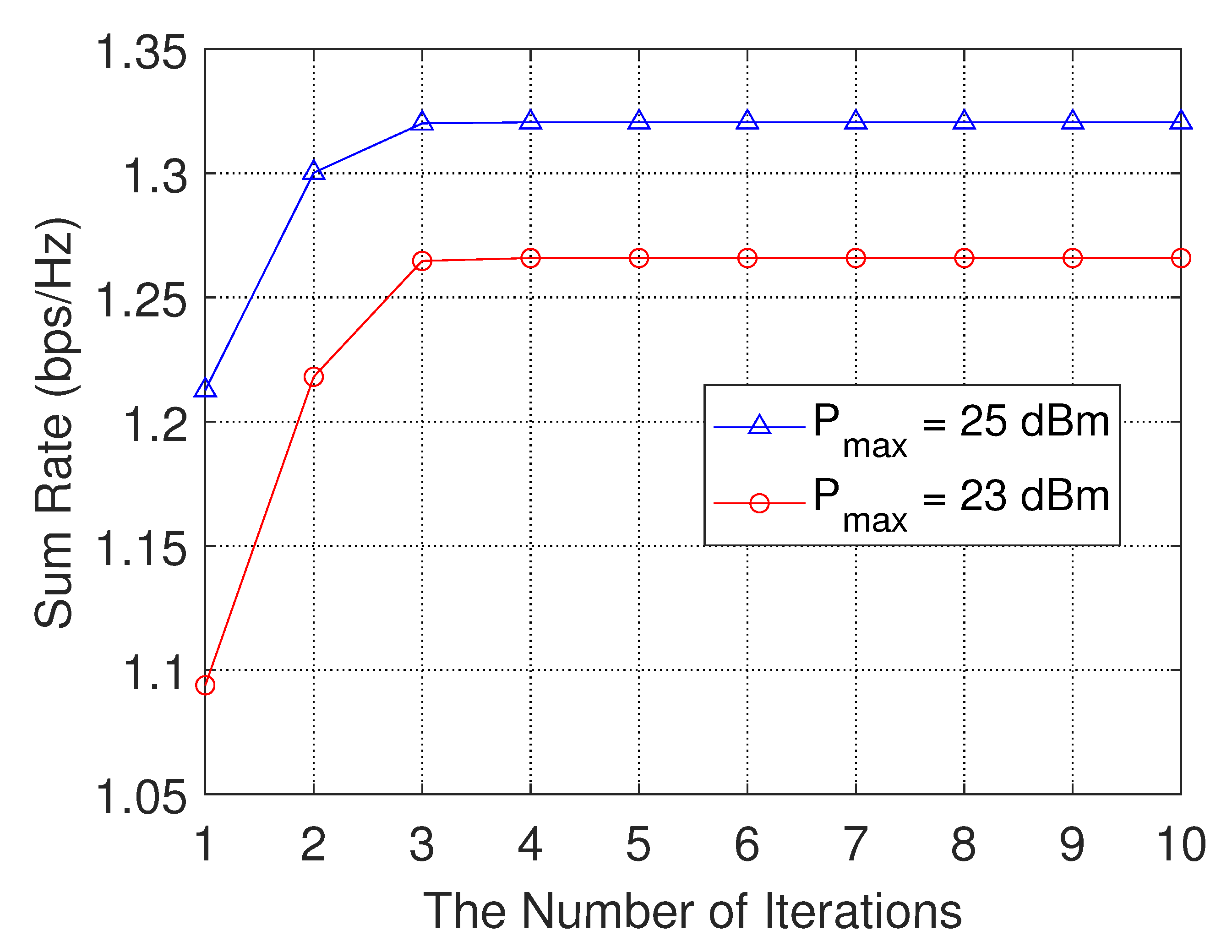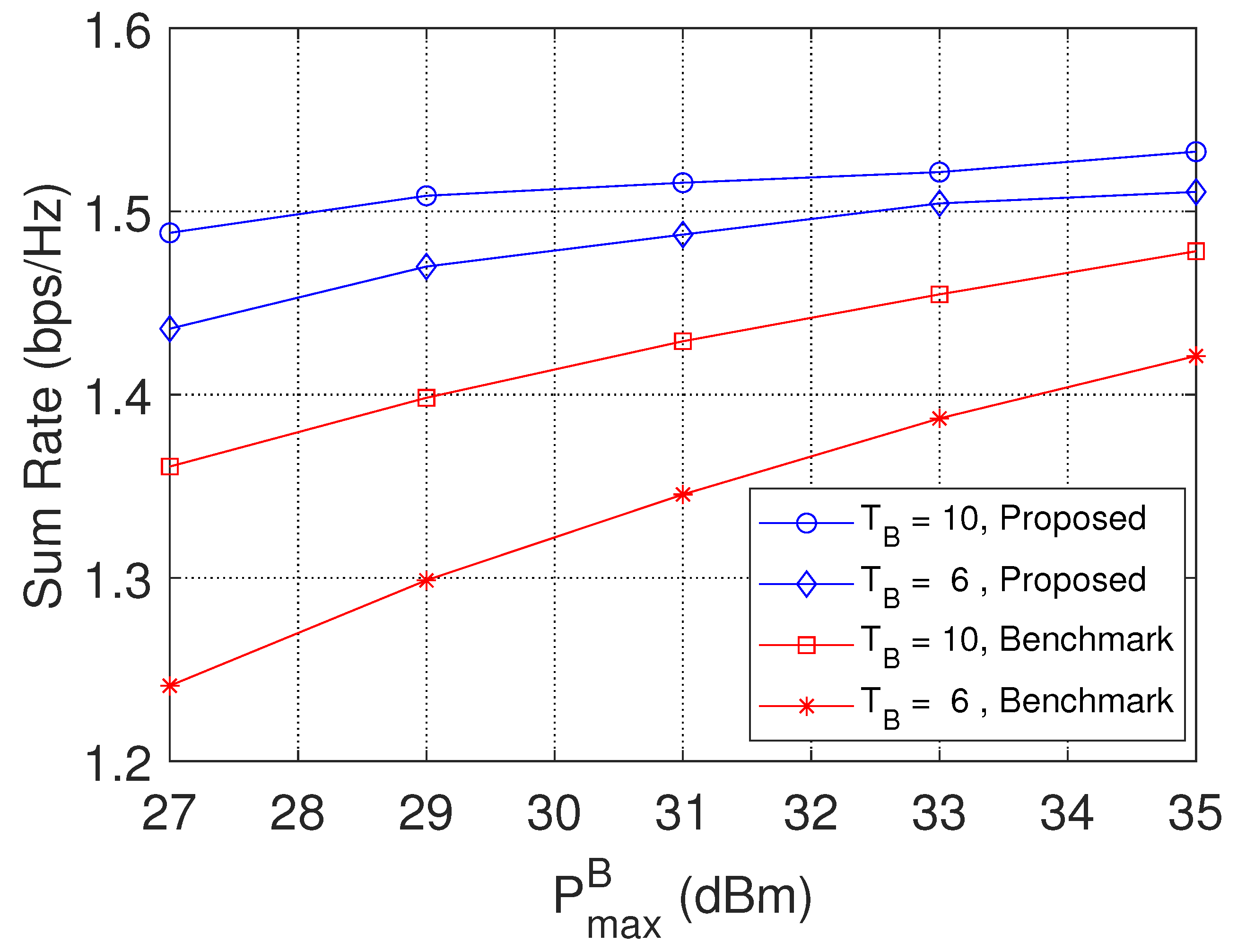Optimal Designs of SVC-Based Content Placement and Delivery in Wireless Caching Networks
Abstract
1. Introduction
- •
- Considering the different time-scales of content caching and transmission, this paper proposed a two-stage design. During the content placement phase, this work studied the optimal caching strategy to minimize the maximal transmission delay. Then, for the transmission phase, we formulated and solved the sum rate optimization problem, and then transformed the problem into the convex form by some useful approximation methods.
- •
- To provide multi-level viewing qualities to end users, SVC was introduced into the content caching and transmission designs. The SVC-based layers are cached in the local caches of helpers, and the layer sets with the different numbers of layers can be provided to users depending on their preferences.
- •
- In the content transmission phase, the sum rate optimization problem was formulated, which is non-convex. To effectively solve the problem, some useful transformation methods were adopted, i.e., semi-definite relaxation (SDR), successive convex approximation (SCA), and arithmetic-geometric mean (AGM) inequality. The nonconvex problem was then transformed into a convex problem and solved by the CVX solver. Additionally, this paper also performed detailed performance evaluations to demonstrate the effectiveness of the proposed algorithm.
2. Related Work
3. System Model
3.1. Wireless Caching Protocol
3.2. Content Transmission Protocol
4. Optimal Design for Content Placement
5. Optimal Design for Content Delivery
5.1. Problem Formulation
5.2. Proposed Algorithm for Sum Rate Maximization
| Algorithm 1 The proposed algorithm for solving problem (16) |
| (1) Initialization: Set and the maximum number of iteration is N. Define the threshold , where is large enough. |
| (2) Find feasible (, , , ) to (16). |
| (3) Calculate and by (14) and (15). |
| (4) While () |
| (a) Solve the problem (18) with and , and obtain the optimal solutions and ; |
| (b) Calculate the optimal sum rate ; |
| (c) Update and by (14) and (15); |
| (d) , and . |
| (5) end |
| (6) Set . |
| (7) If rank() = 1 or rank() = 1, use eigenvalue decomposition to obtain the optimal beamforming vectors. Otherwise, apply Gaussion randomization to obtain the beamforming vectors. |
6. Simulation Results
6.1. Simulation Results of Content Placement
6.2. Simulation Results of Content Transmission
7. Conclusions
Author Contributions
Funding
Institutional Review Board Statement
Informed Consent Statement
Data Availability Statement
Conflicts of Interest
Abbreviations
| QoS | Quality of service |
| SVC | Scalable video coding |
| MBS | Macro-cell base station |
| SDR | Semi-definite relaxation |
| SCA | Successive convex approximation |
| AGM | Arithmetic-geometric mean |
| 6G | Sixth generation |
| CRANs | Cloud radio access networks |
| NOMA | Non-orthogonal multiple access |
| SDV | Standard definition vedio |
| HDV | High definition vedio |
| BL | Base layer |
| EL | Enhancement layer |
| D2D | Device-to-device |
| M-Zipf | Mandelbrot-Zipf |
| AGWN | Additive Gaussian white noise |
| SINR | Signal-to-interference-plus-noise ratio |
| SOCP | Second-order cone programming |
| SAGIN | Space-air-ground integrated networks |
| QoE | Quality of experience |
References
- Wang, X.; Chen, M.; Taleb, T.; Ksentini, A.; Leung, V.C. Cache in the air: Exploiting content caching and delivery techniques for 5G systems. IEEE Commun. Mag. 2014, 52, 131–139. [Google Scholar] [CrossRef]
- Tao, M.; Chen, E.; Zhou, H.; Yu, W. Content-Centric Sparse Multicast Beamforming for Cache-Enabled Cloud RAN. IEEE Trans. Wirel. Commun. 2016, 15, 6118–6131. [Google Scholar] [CrossRef]
- Wang, H.; Xia, X.; Song, T.; Xing, Y. Survey on Space-air-ground Integrated Networks in 6G. In Proceedings of the IEEE/CIC International Conference on Communications in China (ICCC Workshops), Xiamen, China, 28–30 July 2021; pp. 315–320. [Google Scholar]
- Zhang, X.; Ren, Y.; Lv, T.; Hanzo, L. Caching Scalable Videos in the Edge of Wireless Cellular Networks. IEEE Netw. 2022, 1–9. [Google Scholar] [CrossRef]
- Maddah-Ali, M.A.; Niesen, U. Fundamental Limits of Caching. IEEE Trans. Inform. Theory 2014, 60, 2856–2867. [Google Scholar] [CrossRef]
- Chen, M.; Saad, W.; Yin, C.; Debbah, M. Echo State Networks for Proactive Caching in Cloud-Based Radio Access Networks with Mobile Users. IEEE Trans. Wirel. Commun. 2017, 16, 3520–3535. [Google Scholar] [CrossRef]
- Wen, W.; Liu, C.; Fu, Y.; Quek, T.Q.S.; Zheng, F.C.; Jin, S. Enhancing Physical Layer Security of Random Caching in Large-Scale Multi-Antenna Heterogeneous Wireless Networks. IEEE Trans. Inf. Forensics Secur. 2020, 15, 2840–2855. [Google Scholar] [CrossRef]
- Zhou, T.; Liang, C.; Chen, Q. Joint Caching and Computing of Software-Defined Space-Air-Ground Integrated Networks for Video Streaming Service Improvement. In Proceedings of the IEEE Vehicular Technology Conference (VTC), Helsinki, Finland, 19–22 June 2022; pp. 1–5. [Google Scholar]
- Cui, H.; Zhang, J.; Geng, Y.; Xiao, Z.; Sun, T.; Zhang, N.; Liu, J.; Wu, Q.; Cao, X. Space-air-ground integrated network (SAGIN) for 6G: Requirements, architecture and challenges. CHN Commun. 2022, 19, 90–108. [Google Scholar] [CrossRef]
- Yang, Z.; Liu, Y.; Chen, Y.; Jiao, L. Learning Automata Based Q-learning for Content Placement in Cooperative Caching. IEEE Trans. Commun. 2020, 68, 3667–3680. [Google Scholar] [CrossRef]
- Li, Q.; Zhang, Y.; Pandharipande, A.; Xiao, Y.; Ge, X. Edge Caching in Wireless Infostation Networks: Deployment and Cache Content Placement. In Proceedings of the IEEE International Conference on Computation, Communication, Kyoto, Japan, 11–15 March 2019; pp. 1–6. [Google Scholar]
- Han, Y.; Ai, L.; Wang, R.; Wu, J.; Liu, D.; Ren, H. Cache Placement Optimization in Mobile Edge Computing Networks with Unaware Environment—An Extended Multi-Armed Bandit Approach. IEEE Trans. Wirel. Commun. 2021, 20, 8119–8133. [Google Scholar] [CrossRef]
- Wang, E.; Dong, Q.; Li, Y.; Zhang, Y. Content Placement Considering the Temporal and Spatial Attributes of Content Popularity in Cache-Enabled UAV Networks. IEEE Wirel. Commun. Lett. 2022, 11, 250–253. [Google Scholar] [CrossRef]
- Zhang, X.; Lv, T.; Ren, Y.; Lin, Z. Joint Content Push and Transmission in NOMA with SWIPT Caching Helper. IEEE Commun. Lett. 2020, 24, 922–925. [Google Scholar] [CrossRef]
- Ding, Z.; Fan, P.; Karagiannidis, G.K.; Schober, R.; Poor, H.V. NOMA Assisted Wireless Caching: Strategies and Performance Analysis. IEEE Trans. Commun. 2018, 66, 4854–4876. [Google Scholar] [CrossRef]
- Ma, J.; Liu, L.; Song, H.; Shafin, R.; Shang, B.; Fan, P. Scalable Video Transmission in Cache-Aided Device-to-Device Networks. IEEE Trans. Wirel. Commun. 2020, 19, 4247–4261. [Google Scholar] [CrossRef]
- Zhu, H.; Cao, Y.; Jiang, T.; Zhang, Q. Scalable NOMA Multicast for SVC Streams in Cellular Networks. IEEE Trans. Commun. 2018, 66, 6339–6352. [Google Scholar] [CrossRef]
- Guo, C.; Cui, Y.; Ng, D.W.K.; Liu, Z. Multi-Quality Multicast Beamforming with Scalable Video Coding. IEEE Trans. Commun. 2018, 66, 5662–5677. [Google Scholar] [CrossRef]
- Liu, W.; Zhang, G.; Gao, Q. SVC-aware Cache Coordination Schemes for Dynamic Adaptive Streaming in Named Data Networking. In Proceedings of the IEEE International Conference on Communications (ICC), Dublin, Ireland, 7–11 June 2020; pp. 1–6. [Google Scholar]
- Lee, M.C.; Ji, M.; Molisch, A.F.; Sastry, N. Throughput-Outage Analysis and Evaluation of Cache-Aided D2D Networks with Measured Popularity Distributions. IEEE Trans. Wirel. Commun. 2019, 18, 5316–5332. [Google Scholar] [CrossRef]
- Breslau, L.; Cao, P.; Fan, L.; Phillips, G.; Shenker, S. Web caching and Zipf-like distributions: Evidence and implications. In Proceedings of the IEEE Conference on Computer Communications, New York, NY, USA, 21–25 March 1999; pp. 126–134. [Google Scholar]
- Wu, L.; Zhang, W. Caching-Based Scalable Video Transmission over Cellular Networks. IEEE Commun. Lett. 2016, 20, 1156–1159. [Google Scholar] [CrossRef]
- Luo, Z.q.; Ma, W.k.; So, A.M.c.; Ye, Y.; Zhang, S. Semidefinite Relaxation of Quadratic Optimization Problems. IEEE Signal Process. Mag. 2010, 27, 20–34. [Google Scholar] [CrossRef]
- Gao, H.; Lv, T.; Wang, W.; Beaulieu, N.C. Energy-Efficient and Secure Beamforming for Self-Sustainable Relay-Aided Multicast Networks. IEEE Signal Process. Lett. 2016, 23, 1509–1513. [Google Scholar] [CrossRef]
- Wang, K.Y.; So, A.M.C.; Chang, T.H.; Ma, W.K.; Chi, C.Y. Outage Constrained Robust Transmit Optimization for Multiuser MISO Downlinks: Tractable Approximations by Conic Optimization. IEEE Trans. Signal Process. 2014, 62, 5690–5705. [Google Scholar] [CrossRef]






Disclaimer/Publisher’s Note: The statements, opinions and data contained in all publications are solely those of the individual author(s) and contributor(s) and not of MDPI and/or the editor(s). MDPI and/or the editor(s) disclaim responsibility for any injury to people or property resulting from any ideas, methods, instructions or products referred to in the content. |
© 2023 by the authors. Licensee MDPI, Basel, Switzerland. This article is an open access article distributed under the terms and conditions of the Creative Commons Attribution (CC BY) license (https://creativecommons.org/licenses/by/4.0/).
Share and Cite
Zhang, X.; Zhang, L.; Ren, Y.; Jiang, J.; Wang, J. Optimal Designs of SVC-Based Content Placement and Delivery in Wireless Caching Networks. Sensors 2023, 23, 4823. https://doi.org/10.3390/s23104823
Zhang X, Zhang L, Ren Y, Jiang J, Wang J. Optimal Designs of SVC-Based Content Placement and Delivery in Wireless Caching Networks. Sensors. 2023; 23(10):4823. https://doi.org/10.3390/s23104823
Chicago/Turabian StyleZhang, Xuewei, Lin Zhang, Yuan Ren, Jing Jiang, and Junxuan Wang. 2023. "Optimal Designs of SVC-Based Content Placement and Delivery in Wireless Caching Networks" Sensors 23, no. 10: 4823. https://doi.org/10.3390/s23104823
APA StyleZhang, X., Zhang, L., Ren, Y., Jiang, J., & Wang, J. (2023). Optimal Designs of SVC-Based Content Placement and Delivery in Wireless Caching Networks. Sensors, 23(10), 4823. https://doi.org/10.3390/s23104823






